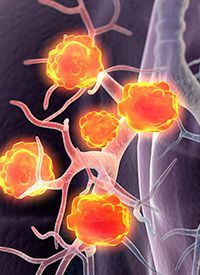Article
Durvalumab Plus Concurrent Radiotherapy Meets PFS End Point in Locally Advanced NSCLC
Author(s):
Treatment with durvalumab and concurrent radiotherapy provided a significant benefit in progression-free survival in patients with locally advanced non–small cell lung cancer, meeting the primary end point of the phase 2 DOLPHIN trial.

Treatment with durvalumab (Imfinzi) and concurrent radiotherapy provided a significant benefit in progression-free survival (PFS) in patients with locally advanced non–small cell lung cancer (NSCLC), meeting the primary end point of the phase 2 DOLPHIN trial (JapicCTI-94840).1
The findings, which were presented at the 2022 World Conference on Lung Cancer, showed that at a median follow-up of 18.7 months, patients treated with durvalumab and concurrent radiotherapy (n = 35) experienced a 12-month PFS rate of 72.1% (90% CI, 59.1%-85.1).
“We assumed the [12-month PFS] threshold to be 28%. The primary end point was met,” said lead study author Motoko Tachihara, MD, PhD, an associate professor at the Kobe University Graduate School of Medicine in Kobe, Japan, in a presentation of the data.
Concurrent chemoradiotherapy followed by durvalumab has been the standard of care for patients with unresectable, locally advanced NSCLC. However, due to adverse effects (AEs) or poor performance status, approximately 25% of patients are unfit to receive durvalumab.
Since the combination of radiotherapy and immunotherapy has been shown to produce a synergistic effect, the DOLPHIN trial aimed to evaluate concurrent treatment with durvalumab and radiotherapy in patients with PD-L1–positive, unresectable, locally advanced NSCLC without chemotherapy.
To enroll in the trial, patients were required to have suspected unresectable stage III or postoperative recurrent NSCLC at primary registration. They also needed to have an ECOG performance status of 0 or 1. At the trial’s secondary registration, patients needed to have confirmed unresectable stage III or postoperative recurrent NSCLC with a PD-L1 expression of at least 1%. Patients were also required to be eligible for treatment per radiation protocol.
Once enrolled, patients received 10 mg/kg of durvalumab plus 60 Gy of radiation therapy every 2 weeks. Treatment continued for up to 1 year unless patients experienced disease progression or unacceptable toxicity.
The primary end point of the trial was 12-month PFS rate, as assessed by independent central review. The threshold for 12-month PFS rate was 28%, and the expected rate was 50%. Secondary end points included PFS, overall survival, objective response rate (ORR), disease-control rate (DCR), treatment completion rate, time to death or distant metastasis, and safety.
The median age of enrolled patients was 72 years (range, 44-83), and 88.6% were male. Most were current (51.4%) or former (45.7%) smokers. With regard to tumor pathology, 54.3% of patients had adenocarcinoma, 42.9% had squamous cell carcinoma, and 2.9% had a pathology not otherwise specified. With regard to staging, 25.7% of patients had postoperative recurrence, 45.7% had stage IIIA disease, 20.0% had stage IIIB disease, and 8.6% had stage IIIC disease. Patients either had an ECOG performance status of 0 (54.3%) or 1 (45.7%). The median PD-L1 tumor proportion score was 60 (range, 1-100), and 70.6% of patients underwent 3D-CRT to determine radiation dosing.
Additional data among 33 evaluable patients showed that the ORR achieved with durvalumab and concurrent radiotherapy was 90.9% (95% CI, 75.7%-98.1%), which included a complete response rate of 36.4%, a partial response rate of 54.5%, and a stable disease rate of 9.1%. No patients experienced progressive disease. The DCR rate with this approach was 100% (95% CI, 89.4%-100%).
Regarding safety among evaluable patients (n = 34), at least 1 AE of any grade occurred in all patients, 47.1% had a grade 3/4 AE, and 2 patients experienced a grade 5 AE. AEs led to treatment discontinuation of durvalumab in 16.6% of patients, and no patients discontinued radiotherapy due to AEs. Any-grade treatment-related AEs occurred in 88.2% of patients, serious AEs were reported in 38.2% of patients, and severe immune-mediated AEs occurred in 29.4% of patients.
Any-grade pneumonitis or radiation pneumonitis was reported in 61.8% of patients, including 11.8% who experienced a grade 3/4 event. No patients had grade 5 pneumonitis or radiation pneumonitis. Two patients discontinued durvalumab due to pneumonitis or radiation pneumonitis.
This treatment strategy is promising with tolerable AEs, and [it is] appropriate for study in phase 3 trials,” Tachihara concluded.
Reference
Tachihara M, Tsujino K, Shimokawa M, et al. Phase II study of durvalumab plus concurrent radiotherapy in unresectable locally advanced NSCLC: DOLPHIN study (WJOG11619L). Presented at: 2022 World Conference on Lung Cancer; August 6-9, 2022; Vienna, Austria. Abstract MA06.04









%20(2)%201-Recovered-Recovered-Recovered-Recovered-Recovered.jpg?fit=crop&auto=format)